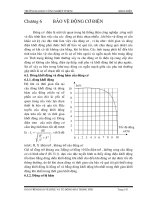Seventh Edition - Chương 6 pdf
Bạn đang xem bản rút gọn của tài liệu. Xem và tải ngay bản đầy đủ của tài liệu tại đây (467.02 KB, 57 trang )
Slide 6.1
© The McGraw-Hill Companies, 2007
Object-Oriented and
Classical Software
Engineering
Seventh Edition, WCB/McGraw-Hill, 2007
Stephen R. Schach
Slide 6.2
© The McGraw-Hill Companies, 2007
CHAPTER 6
TESTING
Slide 6.3
© The McGraw-Hill Companies, 2007
Overview
Quality issues
Non-execution-based testing
Execution-based testing
What should be tested?
Testing versus correctness proofs
Who should perform execution-based testing?
When testing stops
Slide 6.4
© The McGraw-Hill Companies, 2007
Testing
There are two basic types of testing
Execution-based testing
Non-execution-based testing
Slide 6.5
© The McGraw-Hill Companies, 2007
Testing (contd)
“V & V”
Verification
Determine if the workflow was completed correctly
Validation
Determine if the product as a whole satisfies its requirements
Slide 6.6
© The McGraw-Hill Companies, 2007
Testing (contd)
Warning
The term “verify” is also used for all non-execution-
based testing
Slide 6.7
© The McGraw-Hill Companies, 2007
6.1 Software Quality
Not “excellence”
The extent to which software satisfies its
specifications
Every software professional is responsible for
ensuring that his or her work is correct
Quality must be built in from the beginning
Slide 6.8
© The McGraw-Hill Companies, 2007
6.1.1 Software Quality Assurance
The members of the SQA group must ensure that
the developers are doing high-quality work
At the end of each workflow
When the product is complete
In addition, quality assurance must be applied to
The process itself
Example: Standards
Slide 6.9
© The McGraw-Hill Companies, 2007
6.1.2 Managerial Independence
There must be managerial independence between
The development group
The SQA group
Neither group should have power over the other
Slide 6.10
© The McGraw-Hill Companies, 2007
Managerial Independence (contd)
More senior management must decide whether to
Deliver the product on time but with faults, or
Test further and deliver the product late
The decision must take into account the interests
of the client and the development organization
Slide 6.11
© The McGraw-Hill Companies, 2007
6.2 Non-Execution-Based Testing
Underlying principles
We should not review our own work
Group synergy
Slide 6.12
© The McGraw-Hill Companies, 2007
6.2.1 Walkthroughs
A walkthrough team consists of from four to six
members
It includes representatives of
The team responsible for the current workflow
The team responsible for the next workflow
The SQA group
The walkthrough is preceded by preparation
Lists of items
Items not understood
Items that appear to be incorrect
Slide 6.13
© The McGraw-Hill Companies, 2007
6.2.2 Managing Walkthroughs
The walkthrough team is chaired by the SQA
representative
In a walkthrough we detect faults, not correct them
A correction produced by a committee is likely to be of
low quality
The cost of a committee correction is too high
Not all items flagged are actually incorrect
A walkthrough should not last longer than 2 hours
There is no time to correct faults as well
Slide 6.14
© The McGraw-Hill Companies, 2007
Managing Walkthroughs (contd)
A walkthrough must be document-driven, rather
than participant-driven
Verbalization leads to fault finding
A walkthrough should never be used for
performance appraisal
Slide 6.15
© The McGraw-Hill Companies, 2007
6.2.3 Inspections
An inspection has five formal steps
Overview
Preparation, aided by statistics of fault types
Inspection
Rework
Follow-up
Slide 6.16
© The McGraw-Hill Companies, 2007
Inspections (contd)
An inspection team has four members
Moderator
A member of the team performing the current workflow
A member of the team performing the next workflow
A member of the SQA group
Special roles are played by the
Moderator
Reader
Recorder
Slide 6.17
© The McGraw-Hill Companies, 2007
Fault Statistics
Faults are recorded by severity
Example:
Major or minor
Faults are recorded by fault type
Examples of design faults:
Not all specification items have been addressed
Actual and formal arguments do not correspond
Slide 6.18
© The McGraw-Hill Companies, 2007
Fault Statistics (contd)
For a given workflow, we compare current fault
rates with those of previous products
We take action if there are a disproportionate
number of faults in an artifact
Redesigning from scratch is a good alternative
We carry forward fault statistics to the next
workflow
We may not detect all faults of a particular type in the
current inspection
Slide 6.19
© The McGraw-Hill Companies, 2007
Statistics on Inspections
IBM inspections showed up
82% of all detected faults (1976)
70% of all detected faults (1978)
93% of all detected faults (1986)
Switching system
90% decrease in the cost of detecting faults (1986)
JPL
Four major faults, 14 minor faults per 2 hours (1990)
Savings of $25,000 per inspection
The number of faults decreased exponentially by phase
(1992)
Slide 6.20
© The McGraw-Hill Companies, 2007
Statistics on Inspections (contd)
Warning
Fault statistics should never be used for
performance appraisal
“Killing the goose that lays the golden eggs”
Slide 6.21
© The McGraw-Hill Companies, 2007
6.2.4 Comparison of Inspections and Walkthroughs
Walkthrough
Two-step, informal process
Preparation
Analysis
Inspection
Five-step, formal process
Overview
Preparation
Inspection
Rework
Follow-up
Slide 6.22
© The McGraw-Hill Companies, 2007
6.2.5 Strengths and Weaknesses of Reviews
Reviews can be effective
Faults are detected early in the process
Reviews are less effective if the process is
inadequate
Large-scale software should consist of smaller, largely
independent pieces
The documentation of the previous workflows has to be
complete and available online
Slide 6.23
© The McGraw-Hill Companies, 2007
6.2.6 Metrics for Inspections
Inspection rate (e.g., design pages inspected per
hour)
Fault density (e.g., faults per KLOC inspected)
Fault detection rate (e.g., faults detected per hour)
Fault detection efficiency (e.g., number of major,
minor faults detected per hour)
Slide 6.24
© The McGraw-Hill Companies, 2007
Metrics for Inspections (contd)
Does a 50% increase in the fault detection rate
mean that
Quality has decreased? Or
The inspection process is more efficient?
Slide 6.25
© The McGraw-Hill Companies, 2007
6.3 Execution-Based Testing
Organizations spend up to 50% of their software
budget on testing
But delivered software is frequently unreliable
Dijkstra (1972)
“Program testing can be a very effective way to show
the presence of bugs, but it is hopelessly inadequate for
showing their absence”









